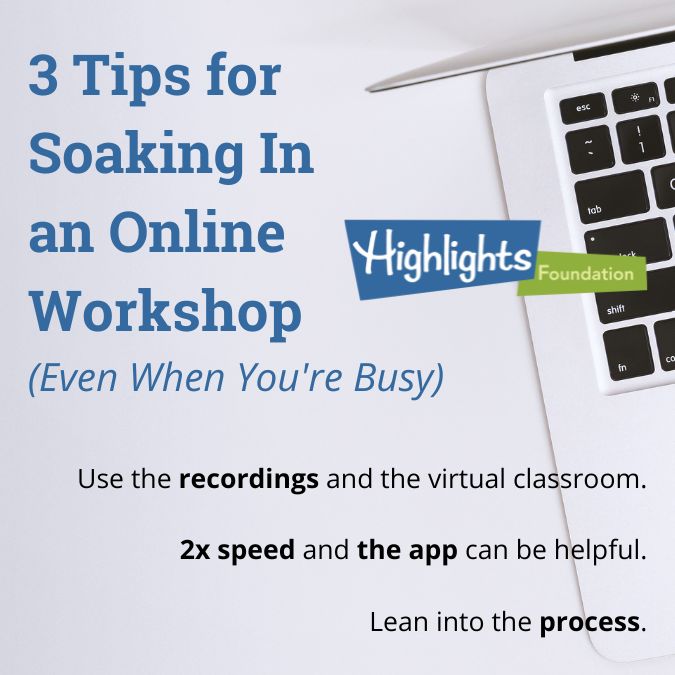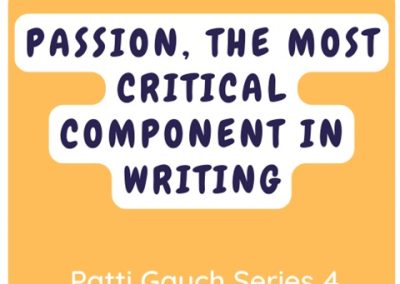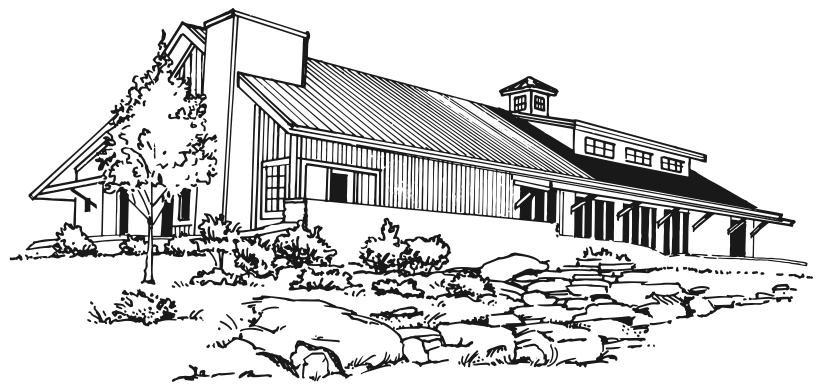My primary purpose for doing so was to see an online course from a student’s perspective. I had visited an in-person workshop at the retreat center a few years ago (pre-pandemic), but life had been so busy that I hadn’t made time for an online workshop.
It was always in the back of my mind, though—which, ironically enough, we hear a lot from folks who know about the Foundation but haven’t taken a workshop yet.
A Little Bit of Backstory: Why I Chose The Crash Course
My colleagues at the Highlights Foundation chuckle when I call them “writerly,” but don’t include myself in that designation. They lovingly prod me forward. “The bug has bitten you,” they’d say.
So when I uttered the words, “I have this idea…” they opened their eyes wide and said: “Um, you know it’s time to take The Crash Course, right?”
I knew they were right, so I cleared it with the Foundation and emailed Harold, the lead faculty. He was welcoming. “See you in the session!” he said.
My first online workship would officially be The Crash Course in Children’s Publishing.
My First Session
On the night of introductions, I was blown away by those (virtually) around me.
There were people who had a single spark for a story (like me), and others who had been writing and exploring ideas for years.
There were people just starting out, and others who were at various stages of the publishing process but looking for more direction or a refresher.
Then there was editor Harold Underdown, leading us.
Listening to them was lovely. It was inspiring just to feel the energy of my fellow humans, committing their time and effort to writing and creating for kids.
Then it got real. Ha!
Could I Make This Happen?
Harold laid out the upcoming the course, and helped us understand what to expect. It was almost funny. There I was, already very familiar with what the course covered and how it was structured, and I still felt myself feeling a little overwhelmed.
I have two young kids, and my work. At the time I had the pressures of regular daily life, plus an impending holiday season.
How was I going to give the course the time and attention it deserved? I knew I wanted to do it, but the rubber was meeting the road.
Working Through the Course
I won’t go into all the details, but I did make it to the end! And by the time it was over, I felt proud.
Truth be told, I didn’t have the time to take advantage of every single resource available to me during the workshop. There were too many in the virtual classroom to count.
But I learned A TON. And as I shared in the discussion boards—though I had already known (in my head) what it took to move a story from “idea” to “book,” I now felt it viscerally, and understood the process more fully.
During the closing session—as we celebrated each other and thanked Harold (and author Leah Henderson and agent Linda Epstein) for their insight—I was proud of myself for making it happen, and excited about the future.

3 Tips for Soaking in a Workshop, Even When You’re Busy
Here were three things that helped me make the most of my experience.
Perhaps they’ll be helpful for a fellow (busy) “newbie” like me, who isn’t quite sure if they can make an online workshop happen.
1. Use the recordings and the virtual classroom.
This is one of those things I knew in my head, but was helpful to experience firsthand.
There are many people who take Highlights Foundation workshops with different schedules, from different time zones or even different continents.
I knew this!
We do our best to make it clear in the course descriptions when it’s important/essential to come to the live sessions, and when it’s OK to use the recordings. (You can also double check with our staff if you’d like more advice about this.)
But again, while I knew it in my head, I understood it more fully once I experienced it.
The Crash Course is a workshop with a lot of flexibility, especially if you can’t attend some or even all of the sessions. There is even a mix of live zoom sessions and pre-recorded content in terms of the material delivery.
In my case, I was able to make it to most of the live evening sessions via Zoom—though I had to duck out sometimes to attend to a personal matter (i.e. a kid who needed a snack or a hug).
When the content was already pre-recorded, or when I needed to watch a recording, I popped in my headphones and watched or listened via the virtual classroom.
2. 2x speed and the app can be helpful.
Speaking of listening to the recordings, I downloaded the virtual classroom’s app (it’s called Canvas), and used that to listen to the recordings on my phone.
I also tended to listen to the recordings on 2x speed if I was in a time crunch. While that sometimes meant “rewinding” to listen to a certain point or session again to process it, it still helped me fit the workshop’s content into my schedule when I was pressed for time. Closed captioning is also there if you need it.
I did prefer engaging in the discussion boards on the desktop version of the classroom, though. While that is also possible via the app, doing so on my laptop was my preference.
3. Lean into the process, especially what might challenge you the most.
Most of The Crash Course is centered around learning about the publishing industry, but there is also some craft content. Special guest Leah Henderson offered some pre-recorded videos to our cohort, and also took us through a live session with some craft exercises on character.
At one point, she asked, “What does your character’s bedroom look like?”
I understood the idea of world-building. I understood the point of character exercises. But up until that moment, my predominantly left-brained self had not even considered that my character would have had a bedroom.
My first thought? “See, I’m not writerly!”
But I took a breath, closed my eyes, and in popped a vision of a poster that my character had hanging in their bedroom.
Maybe I am a “writerly” type, after all.







